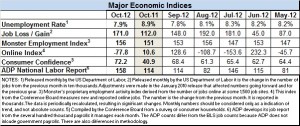 The economy added 171,000 jobs in October, far more than economists were expecting, while the unemployment rate ticked up slightly to 7.9 percent, a development many expected.
The economy added 171,000 jobs in October, far more than economists were expecting, while the unemployment rate ticked up slightly to 7.9 percent, a development many expected.
With most sectors showing job increases, including a 13,000 rise in manufacturing jobs and 17,000 in the beleaguered construction industry, this morning’s report from the U.S. Department of Labor was one of the strongest in months. In addition to the 184,000 non-farm, private sector jobs created in October (offset by losses in government job), the report adjusted upward the initial numbers for September and August by 84,000.
Surveys of economists in the days before this morning’s report had them forecasting the rise in the unemployment rate, but expecting job growth to be in the area of about 125,000 jobs. Yesterday, payroll processor ADP said its own analysis put October’s growth closer to 158,000. That helped send stock prices higher, although economists, wary of ADP’s track record at predicting the government report, largely stuck by their initial predictions.
But the jobs report has turned those predictions on their head. It shows more strength in more sectors than nearly anyone was expecting. In the retail sector, for instance, most categories added jobs, with motor vehicles and parts dealers adding 7,300 jobs. Retail overall was up 36,400 jobs.
In the professional and business services sector, a broad category encompassing employment and temp firms (up by 15,800) to computer system design (up 6,600) and building services such as janitorial (up 13,300), the overall job count grew by 51,000. It was the largest of all the sector increases, surpassing even the 32,500 jobs added in healthcare.
Although the unemployment rate increased, the number of out of work Americans — 12.3 million — was unchanged from September. The 5 million who have been out of work for more than half a year was also unchanged. Another 8.3 million people are working part-time because they can’t find full-time work, and 2.4 million more want work, but because they didn’t search for it during the survey period, aren’t included in the counts of the unemployed.
The Wall Street Journal observed that a broader — and some would say better — measure of unemployment fell to 14.6 percent from September’s 14.7 percent. This so-called U-6 report combines all the different counts of partially employed, unemployed and the marginally attached.
The Journal said the main unemployment rate increase “was driven by positive factors.” These were an increase in the number of workers deciding to rejoin the labor force and start looking for work. “That could be a sign of confidence in the state of the labor market,” the Journal said, a sign borne out by increases in various measure of consumer confidence.
The average workweek stood at 34.4 hours, unchanged for the fourth consecutive week. The manufacturing workweek edged down by .1 of an hour to 40.5, with overtime unchanged at 3.2 hours. Changes in the workweek and overtime are considered indicators of economic growth. With increasing demand, employers first increase the workweek before adding new hires.